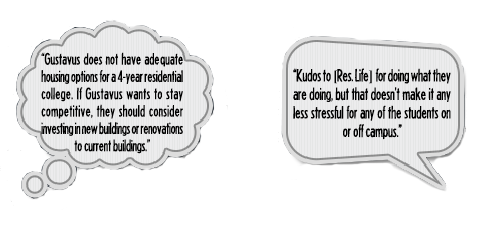As the year’s housing process winds down, many students are still vocalizing strong opinions on the residences they have received and on the current state of the housing process.
Room draw, the process of room selection for students, has traditionally included assigning students random numbers and having them physically selecting rooms from a board in descending order of the priority numbers. The process was moved to an electronic system for a brief time before returning to the current system.
Director of Residential Life Charlie Potts ‘01 has been working in collegiate residential living for the last decade and is currently spending his second year at Gustavus.
“I wanted a system that was more transparent, where students can see immediately where they stack on the priority line. Students can see immediately what room they get, and if they don’t happen to get a top choice, they can see what’s still available. Ultimately, it does give a little more choice. That was key to me,” Potts said.
In recent years, Residential Life has been reaching out and broadening the scope of how students receive information on housing through expanding the residential life homepage and connecting through social media outlets such as Facebook and Twitter to better provide concrete information in an accessible way to students and parents.
“The biggest step in understanding the housing process is that students have to read the website. Some of the email information doesn’t make sense if you don’t read the website. For instance, I got several questions about whether we take average number or highest number for on-campus housing—and the answer (the highest number)is right on the Room Draw website under “What does my Room Draw number mean?,” so thoroughly reading information presented is really important,” Potts said.
The issues that students have voiced against the housing process are inappropriate and inadequate housing for upperclassmen, the lack of apartments and clusters available, and the difficulty in obtaining off-campus housing.
“[The process] is highly stressful, and it seems difficult to communicate with Res Life exactly what I need. They might be thinking one thing while I interpret that as another, and vice versa. They explain that there are many options for students, but leave it to the students to figure out what they are instead of laying some sort of road map for them,” Sophomore Hannah Miller said.
Other students have been looking towards what the housing process currently means for prospective students.
“Gustavus does not have adequate housing options for a 4-year residential college. The upper-classmen options are not up to par with housing at other schools. Features such as air conditioning, carpet, sinks, and options for suites/grouped rooms are fairly standard for upperclassmen housing at other schools and are not featured at Gustavus. Students should consider these options when choosing a college. If Gustavus wants to stay competitive, they should consider investing in new buildings and/or renovations to current buildings,” Sophomore Rachel Scharf said.
“With the addition of Chapel View last year and the potential for more units to be built there in the future, I don’t think there would be a need [to build] another residence hall soon. There are academic building renovation priorities that are and should be higher on the priority list,” Potts said in regards to circulating ideas of renovation and the building of new residential housing.
Other possible changes to the housing system in the near future could include gender neutral housing.
“[In regards to gender neutral housing] we are moving in a great direction to continue and build that conversation. In working with Queers and Allies (Q & A), they are putting together some research and collecting information from students here and from students at other institutions. In getting that feedback, we are setting ourselves up well to have that conversation on campus,” Potts said.
The housing process differs from year to year, but seems to be a continually evolving process for both Residential Life and students.
“When you try to find housing for 1800 people, you try and find the amount that is fairest for the most people. It is tough when you don’t get exactly what you want, but it’s all a matter of perspective. But I think that students did really well in understanding the process and making it work for them,” Potts said.
In the coming years, it seems that communication will have to improve between students and residential life to reconcile the best methods of housing almost 2,000 students on a small, residential campus, as the college population fluctuates and as student demand and availability of housing changes.
“That has to be the most stressful job because they have to deal with hormonally charged young adults who are only attuned to their own issues while disregarding that everyone else has the exact same complaints. Kudos to them for doing what they are doing, but that doesn’t make it any less stressful for any of the students on or off campus,” Miller said.
